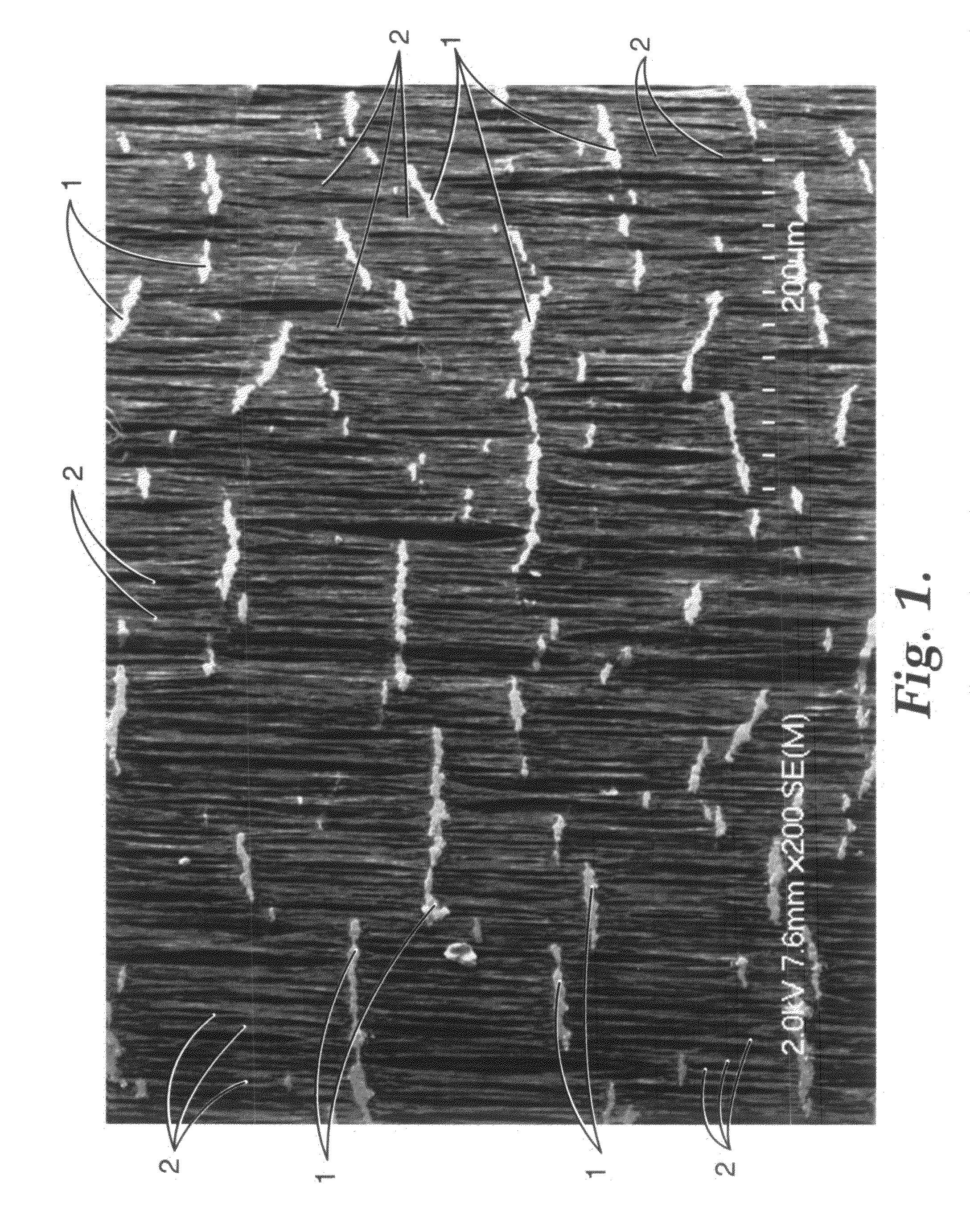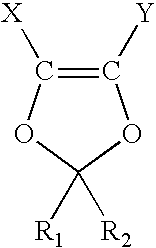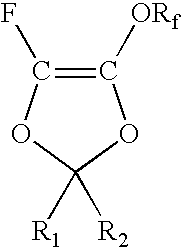Expandable TFE copolymers, method of making, and porous, expended articles thereof
a copolymer and expended material technology, applied in the field of fluoropolymers, can solve the problems of markedly adverse effect on stretchability, reduced crystallinity, and substantial melt moldability of products, and achieve uniform stretching, excellent extrudability, and high-strength porous articles.
- Summary
- Abstract
- Description
- Claims
- Application Information
AI Technical Summary
Benefits of technology
Problems solved by technology
Method used
Image
Examples
example 1
[0043]To a 50-liter, horizontal polymerization reactor equipped with a 3-bladed agitator was added 1.5 Kg wax, 28 Kg of deionized (DI) water, 18 g of ammonium perfluorooctanoic acid (APFO) and 5 g of succinic acid dissolved in about 50 g of DI water. The reactor and contents were heated above the melting point of the wax. The reactor was repeatedly evacuated and pressurized (to about 1 Atm or less) with TFE until the oxygen level was reduced to 20 ppm or less. The contents were briefly agitated at about 60 rpm between evacuation and purge cycles to ensure that the water was deoxygenated.
[0044]The reactor was heated to 83 C and agitated at 60 rpm. Subsequently, 0.8 Mpa of VDF was added followed by addition of TFE until the pressure reached 2.8 Mpa. At this time, KMNO4 in a DI water solution (0.063 g / L) was injected at 80 mL / min until approximately 2 kg of TFE was added. After addition of the 2nd Kg of TFE; the pressure in the reactor was reduced to 50 Kpa using vacuum and pressurized...
example 2
[0048]To a 50-liter, horizontal polymerization reactor equipped with a 3-bladed agitator was added 1.5 Kg wax, 28 Kg of deionized (DI) water, 18 g of ammonium perfluorooctanoic acid (APFO) and 5 g of succinic acid dissolved in about 50 g of DI water. The reactor and contents were heated above the melting point of the wax. The reactor was repeatedly evacuated and pressurized (to about 1 Atm or less) with TFE until the oxygen level was reduced to 20 ppm or less. The contents were briefly agitated at about 60 rpm between evacuation and purge cycles to ensure that the water was deoxygenated.
[0049]The reactor was heated to 83° C. and agitated at 60 rpm. Subsequently, 0.8 Mpa of trifluoroethylene (herein designated TrFE) was added followed by addition of TFE until the pressure reached 2.8 Mpa. At this time, KMNO4 in a DI water solution (0.1 g / L) was injected at 80 mL / min until approximately 0.5 kg of TFE was consumed. At this time, the rate was reduced to 40 mL / min until a second Kg of TF...
example 3
[0054]To a 50-liter, horizontal polymerization reactor equipped with a 3-bladed agitator was added 1.5 Kg wax, 28 Kg of deionized (DI) water, 18 g of ammonium perfluorooctanoic acid (APFO) and 5 g of succinic acid dissolved in about 50 g of DI water. The reactor and contents were heated above the melting point of the wax.
[0055]The reactor was repeatedly evacuated and pressurized (to about 1 Atm or less) with TFE until the oxygen level was reduced to 20 ppm or less. The contents were briefly agitated at about 60 rpm between evacuation and purge cycles to ensure that the water was deoxygenated.
[0056]To the evacuated reactor, 8 mL of PFBE was charged, and the reactor was heated to 83° C. and agitated at 60 rpm. Subsequently, 0.8 Mpa of VDF was added followed by addition of TFE until the pressure reached 2.8 Mpa. At this time, KMNO4 in a DI water solution (0.1 g / L) was injected at 80 mL / min until approximately 2 kg of TFE was added. After addition of the second Kg of TFE, the pressure i...
PUM
| Property | Measurement | Unit |
|---|---|---|
| Fraction | aaaaa | aaaaa |
| Fraction | aaaaa | aaaaa |
| Percent by mass | aaaaa | aaaaa |
Abstract
Description
Claims
Application Information
 Login to View More
Login to View More - R&D
- Intellectual Property
- Life Sciences
- Materials
- Tech Scout
- Unparalleled Data Quality
- Higher Quality Content
- 60% Fewer Hallucinations
Browse by: Latest US Patents, China's latest patents, Technical Efficacy Thesaurus, Application Domain, Technology Topic, Popular Technical Reports.
© 2025 PatSnap. All rights reserved.Legal|Privacy policy|Modern Slavery Act Transparency Statement|Sitemap|About US| Contact US: help@patsnap.com



